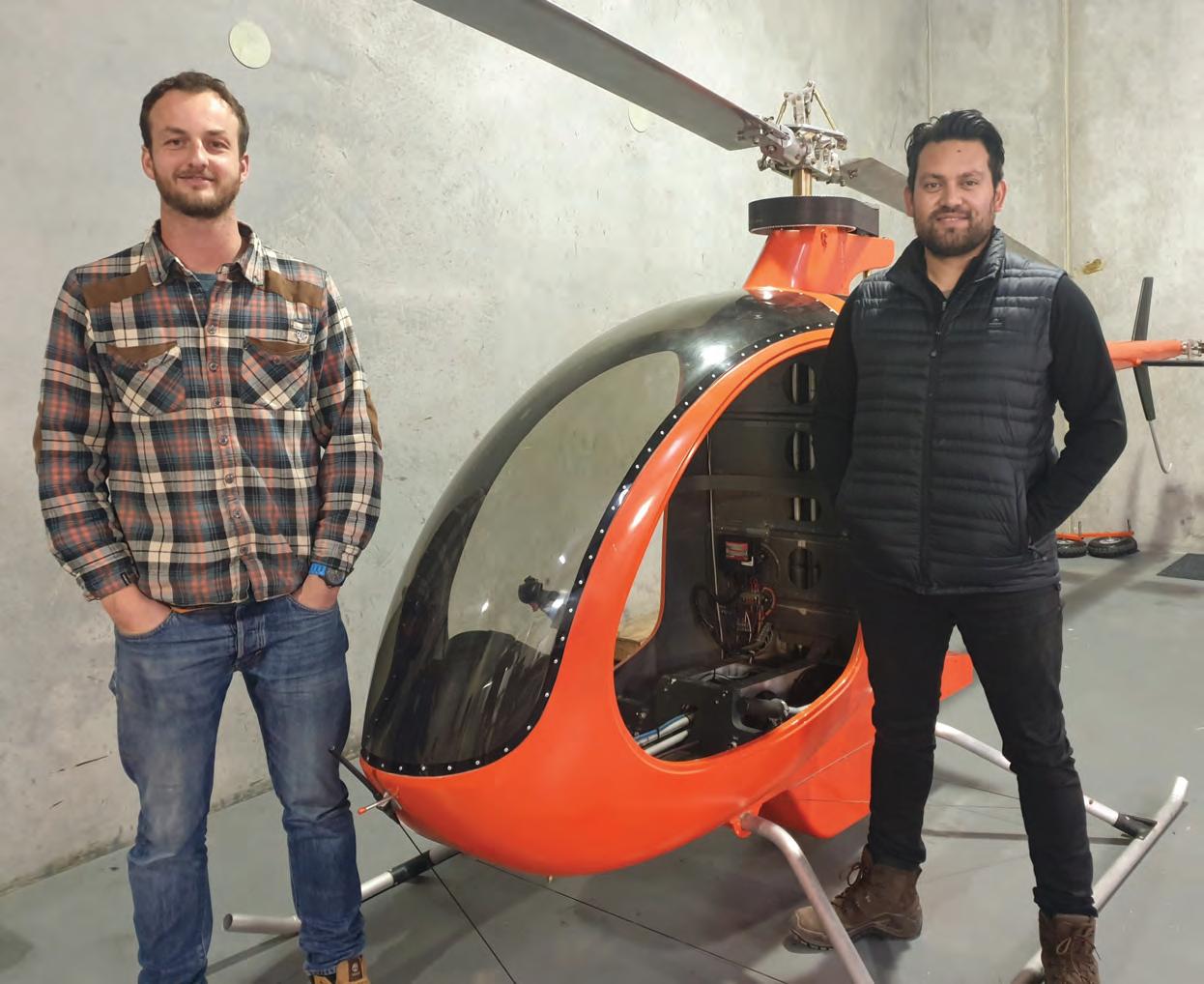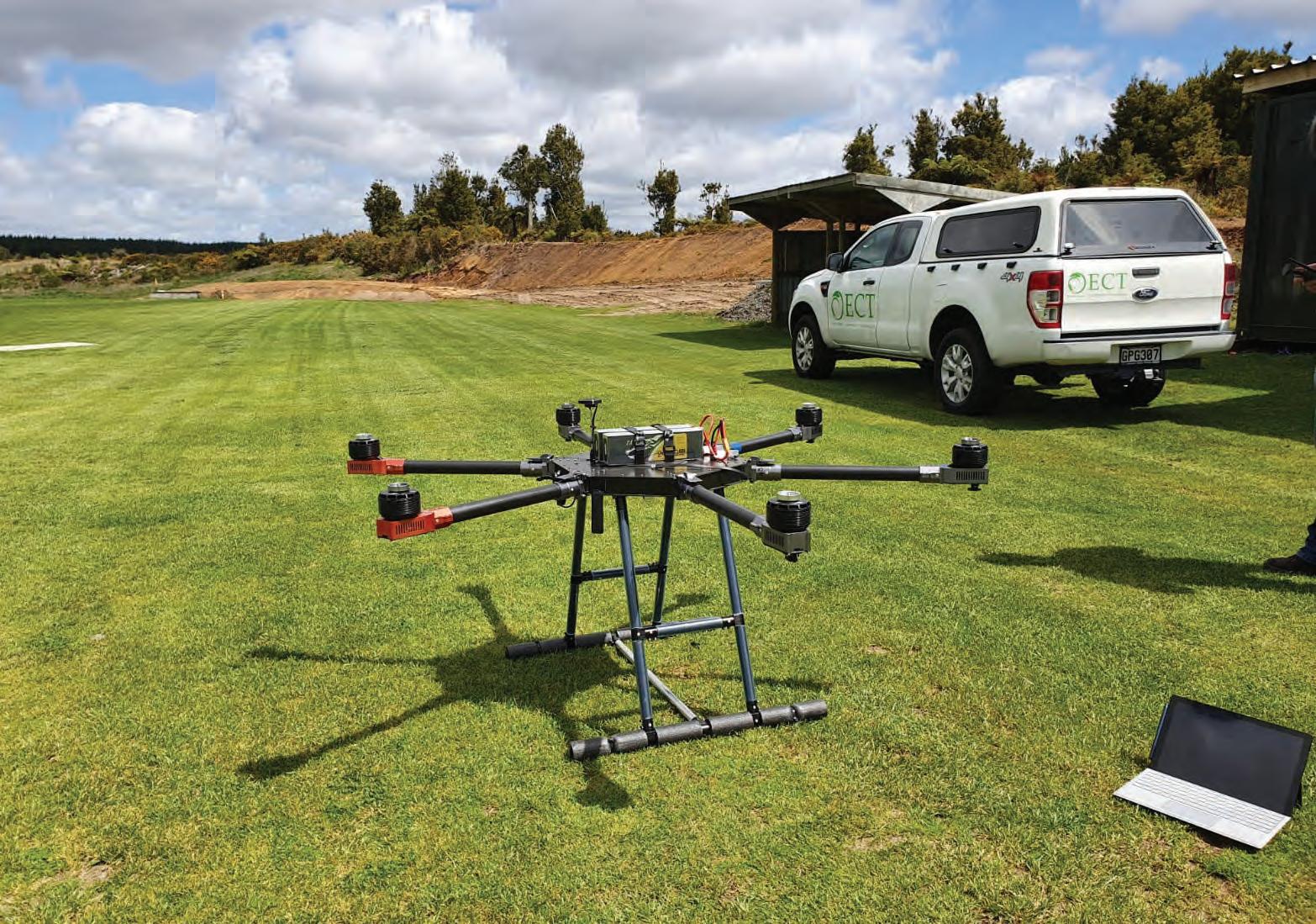
5 minute read
Are drones the key to future-proof conservation?
by CILTNZ
Co-founders of Envico Technologies, Samuel Vye (left) and Cameron Baker. Photos: Envico Technologies
SAMUEL VYE, CO-FOUNDER OF TAURANGA’S ENVICO TECHNOLOGIES (FORMERLY ENVIRONMENT & CONSERVATION TECHNOLOGIES), DISCUSSES WITH DANIEL DUNT THE FUTURE OF DRONES IN CONSERVATION EFFORTS, PROBLEMS FACING THE INDUSTRY, AND WHY THIS INNOVATIVE TECHNOLOGY IS NOT ONLY FOR BIG BUSINESS.
SAMUEL VYE AND CAMERON BAKER founded Envico in 2018. The company was quickly recognised for its leading drone technology and automated ground devices for invasive pest management. Interest in Envico surged in 2019 which led to rapid internal expansion, including bringing several engineers on board, to develop technology for other areas of conservation, including drones for thermal mapping and seed pod delivery – a fast and efficient way to conduct native reforestation.
But how do drones compare to more traditional methods? Mr Vye explains: “It really comes down to cost efficiency, practicality and safety. Drones are easy to get up and running and they’re fast – they do what they need to do and then they return, completing deliveries far faster than ground delivery. Plus, with drones, you don’t have people on the ground scrambling through dangerous territory, or flying helicopters in turbulent wind, which can cause accidents. If a drone goes down, it can be irritating and there are financial repercussions, but there’s no risk to the pilot.” Despite the array of benefits of using drones for conservation, as well as for transport and logistics long-term, there are some issues standing in the way of the technology’s growth. First, battery technology. According to Mr Vye, until we have a robust battery recycling method, and a renewable energy source for charging batteries, the environmental impact means that they are not suitable for heavy-lift drone usage. Additionally, battery drones typically have short flight times of 10-20 minutes, so are unviable for many drone delivery or heavy payload applications. As a result, Envico is moving towards the petrol combustion engine to power its drones. “They can fly for much longer and carry more payload. Obviously, petrol powered drones do emit carbon, however based on calculations comparing our heavy lift drones to helicopters for agricultural/ forestry applications, for example, because our drones are lightweight and the specialist technology used, we do in fact have 85% reduction in carbon emissions compared to a manned helicopter,” Mr Vye clarifies. Cont. on page 12
Despite the array of benefits of using drones for conservation, as well as for transport and logistics long-term, there are some issues standing in the way of the technology’s growth.

So, while some environmentalists may be concerned with the idea of burning fuel, it may well be the best of a bad situation right now, until battery technology improves. Mr Vye is convinced it will be another decade or more before we can seriously begin comparing the combustion engine to electrically powered for heavy-lift drones, but he’s positive that batteries will get there eventually. Regulations are the other major problem facing drones right now: “Regulators are not managing to keep up with technological developments. New Zealand is still at a point where, commercially, it is complex to gain approval to fly beyond visual line of sight (BVLOS),” explains Mr Vye, which of course severely limits applications. The fix? “A robust structure for regulatory approval, including beyond visual line of sight. But first, you need to think about safety implications, like how a manned aircraft would not have an accident with a drone.” Aircraft need to be able to see each other, so an idea could be like airplanes, drones could use Automatic Dependent Surveillance-Broadcast (ADS-B). In New Zealand, like other countries, the Government is running an air-space integration programme, which is all about how we put drones and manned aircraft in the same space without exclusion zones. This is a promising step towards setting up an infrastructure for drones, however all parties need to be happy and the setup must be commercially viable for everyone involved, which is an ongoing conversation. Thankfully, these concerns are mostly pertinent when you begin looking at longdistance drone operation, beyond visual line of sight, or in areas of heavy air traffic. So, while long-haul transportation might be a while away yet, using drones as a conservation tool as well in agriculture, is something we can benefit from right here and now. And it’s not only feasible for big business, either.
According to Mr Vye, there are many options when buying drones, because you can tailor the technology to exactly what it is you need, including size and type. At the same time, it’s not even necessary for businesses to buy their own drones – small drones perhaps, but large drones simply can be too complex to manage and operate, let alone gain the certification and approvals required. “Partnerships, going to suppliers ... that’s how small- to medium-sized businesses can truly benefit from heavy-lift drone technology. That way you benefit from the expertise of another organisation, their certifications, approvals and insurance. There is a whole host of factors to consider if purchasing a heavy-lift drone, far more than a small toy drone, so working with drone specialists can greatly reduce the risk.” Much of the investment in drone technology and start-ups is currently toward passenger carriers which, much like the space sector, is an attractive investment prospect for investors – it’s shiny and futuristic in ways conservation or utility drones are not. However, that’s changing and Envico Technologies are ready to step up. “Passenger drones are an exciting prospect, but the technology required for a viable and cost-efficient system fit for widespread deployment is way off in the future, whereas we’re ready to start using heavy-lift drones for commercial and utility applications right now, particularly as we can conduct BVLOS operations in rural environments.” Envico has ruled out passenger drones for now and is focusing its attention on heavy lift drones for product carrying, which can carry weights of up to 200kg, for two hours and with a 100km range. To support its efforts, in the coming months it will announce a sister company which will focus on the manufacture and supply of these heavy-lift drones.
“The last couple of years has been a bit of a whirlwind, with requests from other countries and organisations who want our advice or services. And we are looking forward to working closely with those interested parties while continuing to push our innovations forward.”
In a matter of years, drones could be the go-to for time and cost-efficient conservation, and it looks like Envico could very well be leading the way – particularly in New Zealand.







